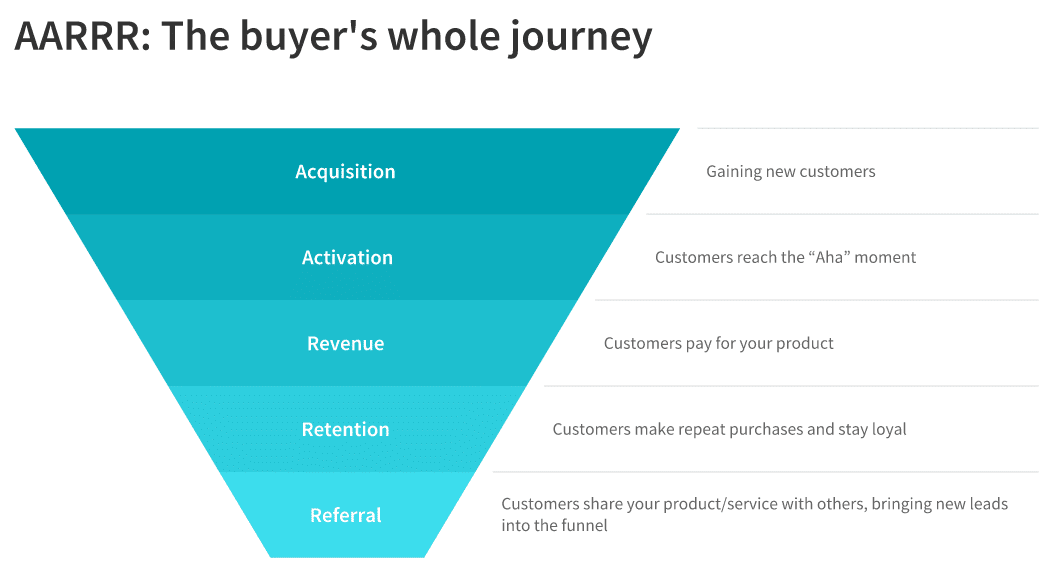If your company isn’t growing, it’s not sustainable. As a marketer, you have a whole suite of strategies available focused on your company’s growth. Collectively, they’re known as growth marketing, and they’ve changed the face of marketing forever.
We’ve put together this ultimate guide to growth marketing to help you choose growth marketing strategies that are right for your brand.
Today, we’ll cover the growth marketing fundamentals. What exactly is growth marketing? What makes it different from traditional marketing? Why should a brand consider doing it? Read on to find out.
What is growth marketing?
Growth marketing is marketing that focuses on customer retention, not just customer acquisition. It understands that cultivating loyal, repeat customers is the best and most reliable way to sustain growth.
Since growth marketing is retention-focused, it looks at the entire marketing funnel or buyer’s journey, rather than just the top of the funnel.
The highest priority for growth marketing is getting customers to make repeat purchases and remain loyal to your business. This is vital to maintaining a profitable business in today’s landscape. After all, if all your customers purchase from you just once and then never come back, your company can’t truly grow.
So many strategies fall under growth marketing. (Yes, any long-term strategy that focuses on retention counts!) Check out our article on growth marketing strategies for more information.
How is growth marketing different from traditional marketing?
Traditional marketing only focuses on the top of the funnel – acquiring new customers and getting them to make their first purchase. It doesn’t look at the life cycle of that customer after the point of purchase.
In contrast, growth marketing focuses on the entire funnel or buyer’s journey. It’s especially focused on the customer retention and referral stages at the funnel’s bottom.
How do growth marketers measure success?
Growth marketers and growth marketing agencies use a set of metrics, known as pirate metrics (AARRR metrics), to measure the success of their marketing efforts and the health of their business as a whole. These metrics align with each stage of the buyer’s journey:
- Acquisition
- Activation
- Revenue
- Retention
- Referral
Learn more about pirate metrics and the corresponding stages of the buyer’s journey.
Advantages of growth marketing
If you haven’t yet focused on the retention stage of the buyer’s journey, it may be time to change your approach. Here are some of the most compelling reasons to do so:
- Even losing a small percentage of your customer base means you’ll need to play catch-up to retain growth. Venture capitalist Tomasz Tunguz estimates, “if a typical SaaS business loses about 2–3% of their customers each month to churn, the business must grow by at least 27%–43% annually to maintain the same revenue.”
- Focusing on customer retention helps cut your customer acquisition costs (CAC). New customers’ first purchases are counteracted by their CAC, but returning customers’ purchases aren’t. So the longer a customer stays with you, and the more purchases they make, the higher their lifetime value to your business becomes.
- Satisfied return customers are more likely to progress to the very bottom of the funnel. This is also known as the referral stage, during which they are likely refer their friends to you. Referrals bring new customers to your company – for free. Furthermore, studies show 83% of people actually trust recommendations more if they come from friends and family.
It pays to focus on retention rather than new customer acquisition. With this approach, you’ll still bring in plenty of new customers and save money in the process.
Is growth hacking the same as growth marketing?
The terms “growth hacking” and “growth marketing” are often used interchangeably. But in practice, there are some key differences between the two:
- Growth hacking is usually about finding single solutions quickly. For example, when a marketing team is struggling to solve a specific problem. These hacks, however, won’t always be a reliable source of income in the long term, as they were carried out with a specific, not a holistic, focus.
- Meanwhile, growth marketing has a wider view: securing the health of your business in the long term. Growth marketers pay attention to key metrics across the entire buyer’s journey for long periods, and tweak processes to create and sustain growth, based on those metrics. Their actions are truly holistic.
Growth marketing best practices
What makes growth marketing successful? The following best practices are vital to growth marketing, no matter which strategies you choose.
Be data-driven
Make sure all your decisions are data-driven. With growth marketing, you must set measurable goals for each stage of the buyer’s journey – acquisition, activation, revenue, retention, and referral.
- Always pay attention to KPIs across the buyer’s journey (the pirate metrics) and make decisions based on that data, not arbitrarily.
- Test and tweak methods over time to see what works, including through A/B testing.
- Survey customers to collect data on their satisfaction, so you can take the needed actions to retain them.
- As you collect and act on data, focus on your business’s long-term health, rather than quick but temporary fixes.
Growth marketers build on successes, but they know that learning from failures is just as crucial. To a growth marketer, failure is not something to be feared, but something to learn from.
Embrace efficiency
Growth marketers love efficiency, and find every opportunity possible to be efficient. Mainly, efficiency is about getting a brand name out there at little to no cost.
For example, growth marketers will focus on SEO and SEM to make sure their brand will be found quicker than other competitors on Google when prospects search for key terms related to their niche. They might also collect emails by offering freebies in exchange for leads’ email addresses. This allows them to conduct free, targeted email marketing to those leads in the long term.
Many growth marketers will also strive to create viral content pieces that people can’t help but share. Viral growth can be unpredictable, but if your content goes viral, it’s one of the quickest ways to generate loads of no-cost publicity.
An alternative to viral content is to create a viral loop. Viral loops are all about creating a cycle of repeated referrals. In this loop, existing customers refer their friends to you. These friends in turn become your customers and refer their own friends – and the loop continues. This potent form of free marketing ties right in with growth marketing’s focus on retention and referrals.
Growth marketers tap into word-of-mouth as a channel at every chance they get. Convincing customers to create user-generated content (UGC) about your brand – social media posts, images, and testimonials – is another efficient strategy. Since people trust the opinions of others who have used your product, UGC is a free and effective way to get your name out there (and further prove the importance of having loyal customers).
Be ready to adapt
Growth marketers have a diverse skill set. When you commit to growth marketing, you must become a jack-of-all-trades who can adapt easily to any situation.
As Useproof puts it: “An effective growth marketer needs to be a contradiction of sorts. Details obsessed but keeps the big picture in mind. Results driven but comfortable with ambiguity. Measures everything and trusts the data but also values human intuition.”
Be niche-focused
Know the importance of quality, niche-focused content. Growth marketers demonstrate expertise in their brand’s niche by creating content. The right content will make your brand more memorable, as people who read and learn from the content will also begin to trust the brand. The trust you build will make it easier to move leads through the funnel.
Growth marketers understand the web already has loads of content. To stand out, it’s important to share their expertise and offer true value. A good practice is to diversify the content marketing strategies, mediums, and channels so you can see what works, but remember not to deviate from your niche.
Provide proof
Use proof to your advantage. When it comes to lead generation, growth marketers benefit from having proof at their disposal because they have already focused on the existing customer experience.
What exactly is included in proof? Social proof, social currency, referrals, reviews, testimonials, UGC, word-of-mouth… basically any validation from existing customers counts as proof. Be sure to provide proof on your website and social media accounts, and make the referring process easy for your customers.
Be creative
Growth marketers are always looking for the most innovative ways to spread the word about their brand. They know whoever thinks of a solid idea first, and is bold enough to go through with it, will have a leg up on the competition. Furthermore, the most creative marketing strategies will become associated with the brand that uses them (Wendy’s tweets are a prime example). So remember to think outside the box when it comes to your strategies!
Create the ‘aha’ moment
Strive to get users to the ‘aha’ moment as quickly as possible. This is the moment users discover the value of your product or service. At this point, it’s easier for users to move through the funnel.
So how do you move people towards this crucial moment? Know and show the true benefits of your product, especially how it can help them achieve their goal. While it’s good to base your decisions on data, it’s also important to tell a story and connect with your audience.
Prioritize the retention and referral stages
Yes, this is a repeated point, but it’s crucial that you stay focused on retention and referrals – also known as the bottom of the funnel.
A growth marketer would rather gain a smaller amount of customers who are more likely to stay engaged than a large amount of customers who probably won’t stick around. In addition, growth marketers are constantly examining the customer experience and figuring out how to improve it for customer loyalty.
Wrapping things up
As you can see, growth marketing – marketing that focuses on retention – has a variety of advantages. It can help you increase your customer lifetime value, reduce acquisition costs, and even bring in new customers through existing customers’ trusted referrals. As long as you keep the entire AARRR funnel in mind and take a holistic view, having a strong growth marketing strategy will pay off in the long run.








